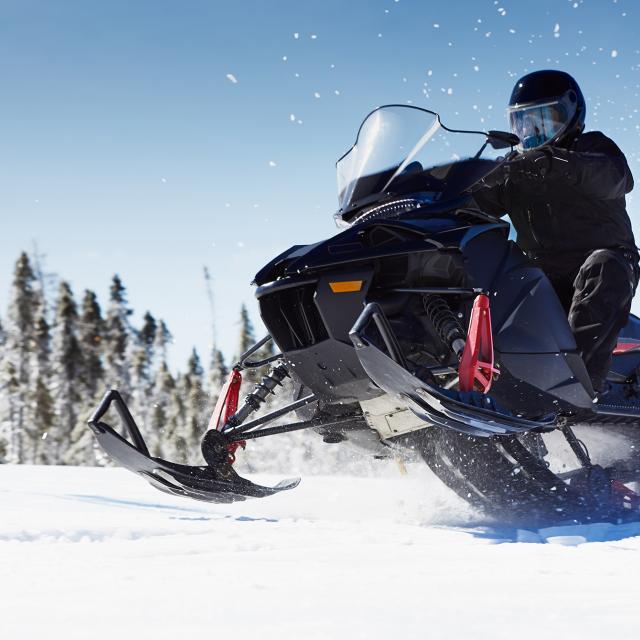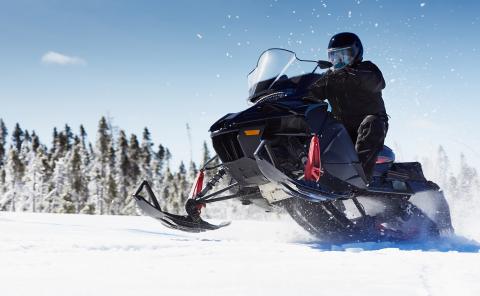What to look for in snowmobile insurance [2024]

For a worry-free snowmobile season, here’s what you need to know about snowmobile insurance. Find out how to interpret the law, protect yourself in case of accidents and injuries, and safeguard your snowmobile with the various coverage options available. Read right to the end for tips and advice on how to snowmobile safely this winter.
Snowmobile insurance : what the law says
Under the Act respecting off-highway vehicles, as a snowmobile owner, you must hold at least $1,000,000 in civil liability insurance. You are required to purchase this insurance from an insurer to cover damage or injury your snowmobile could cause to others. This is Section A in your insurance policy.
What liability insurance covers: It protects you against the financial consequences if your snowmobile causes damage or injury to another person.
Penalty for breaking the law: If you violate the requirement to hold civil liability insurance, you could be fined from $250 to $500.
It’s also important to remember that under the law:
- All snowmobile operators must be at least 16 years of age and hold a valid driver’s licence Drivers 16 and 17 years of age must be licensed and hold a training certificate
- You must register your snowmobile
- The speed limit for snowmobiles is 70 km/h, except where signage indicates a lower speed limit
- The rules about impaired driving in the Highway Safety Code and the Criminal Code also apply to snowmobilers
For more details, see the SAAQ article, Snowmobiles: What the law says.
Snowmobile accidents and injuries: how to protect yourself
While snowmobiling continues to grow in popularity, it still has risks. According to Statistics Canada, snowmobiling was linked to an average of 73 deaths a year between 2013 and 2019 across all provinces and territories. In Québec, Société d’assurance automobile du Québec has reported nearly 2,300 injuries in snowmobile accidents on Sûreté du Québec territory between 2015 and 2020.
Keep in mind that the Automobile Insurance Act does not provide for compensation in case of bodily injury in a snowmobile accident. As a general rule, if you are responsible for an accident causing injury to others, the civil liability portion of your snowmobile insurance will cover the claims, subject to the conditions, limitations, and exclusions in your policy.
Only exception: If the snowmobile accident occurs on a public road and involves an automobile or any other vehicle, the SAAQ plan applies and you may be entitled to compensation for your injuries.
What about damage to your snowmobile in the event of a covered loss? Read on to find out more.
Snowmobile insurance: how to properly protect your snowmobile
An at-fault accident, such as a fire or theft, can cause significant damage to your snowmobile, which will likely require repair. To make sure you’re protected, you must include off-road coverage in your policy. Not to worry—insurers offer a variety of options.
These specific types of coverage are listed in Section B of your insurance policy. You can choose from the following four types:
- Coverage 1 – All perils covers damage to your snowmobile, equipment, and accessories caused by any type of risk (some risks may be excluded).
- Coverage 2 – Collision or upset covers damage to your snowmobile, equipment, and accessories in the event of a collision or rollover.
- Coverage 3 – Perils other than collision or upset covers damage to your snowmobile, equipment, and accessories, including vandalism (e.g., broken glass) and collision with a person or animal.
- Coverage 4 – Specified perils covers damage to your snowmobile, equipment, and accessories from risks specifically named in the policy, including in the case of theft and fire.
Important: These coverage options are subject to the limitations, exclusions, and conditions in your insurance policy. If you wish, you can protect yourself even more by adding additional coverage options to your insurance policy, such as compensation without depreciation or coverage for some of your travel expenses following a covered loss.
FCMQ member and third-party liability insurance
Good to know: When you purchase a trail permit from the Québec Fédération des clubs de motoneige du Québec (FCMQ), you can choose to include $1,000,000 in civil liability insurance coverage with your permit. This protection covers you in the event of a snowmobile accident. However, it is important to note that the FCMQ insurance does not cover damage to your snowmobile.
That’s why you need additional snowmobile insurance from a private insurer such as Promutuel Insurance to cover damage to your snowmobile in the event of an accident.
If you are an FCMQ member and wish to purchase snowmobile insurance from a private insurer, your damage insurance representative will suggest that you remove liability coverage from your insurance policy if possible. That way, you avoid paying for the same coverage twice!
Snowmobile safety: important things to remember
Although snowmobile insurance protects you in the event of an accident, being careful when operating your snowmobile is the best way to avoid accidents when riding on Québec trails. Good driving habits and having all the necessary equipment are the key to safe snowmobiling.
When buying your first snowmobile and at the beginning of each season, make sure you have the following equipment:
- A helmet with visor (or goggles)
- A rear-view mirror
- Warm clothing
- An emergency kit (basic first aid, thermal blanket, water bottle, headlights, tow line, whistle, etc.)
- A drive belt
- A toolkit
- Replacement gloves and socks
- A satellite communication device
- The vehicle registration
- Your driver’s licence
- If you’re a driver age 16 or 17, your training certificate
Follow good snowmobiling practices on the trail:
- Wear your helmet at all times, even off the trail.
- Always keep to your right on trails.
- Obey speed limits.
- Turn on your headlights in low light conditions and inclement weather.
- Tell your loved ones where you’re going.
- Check the weather forecast before starting off.
- Cross frozen waterways only on marked trails.
- Do not drive under the influence of alcohol or drugs.
- Keep a safe distance from the vehicle ahead.
- Obey signage.
THERE so you can snowmobile worry free!
Follow the lead of thousands of other snowmobilers and choose Promutuel Insurance to protect your snowmobile. Explore Québec’s snow-covered trails worry free with snowmobile insurance tailored to your needs.
Ask for a snowmobile insurance quote or contact a damage insurance advisor today!
Happy trails!




